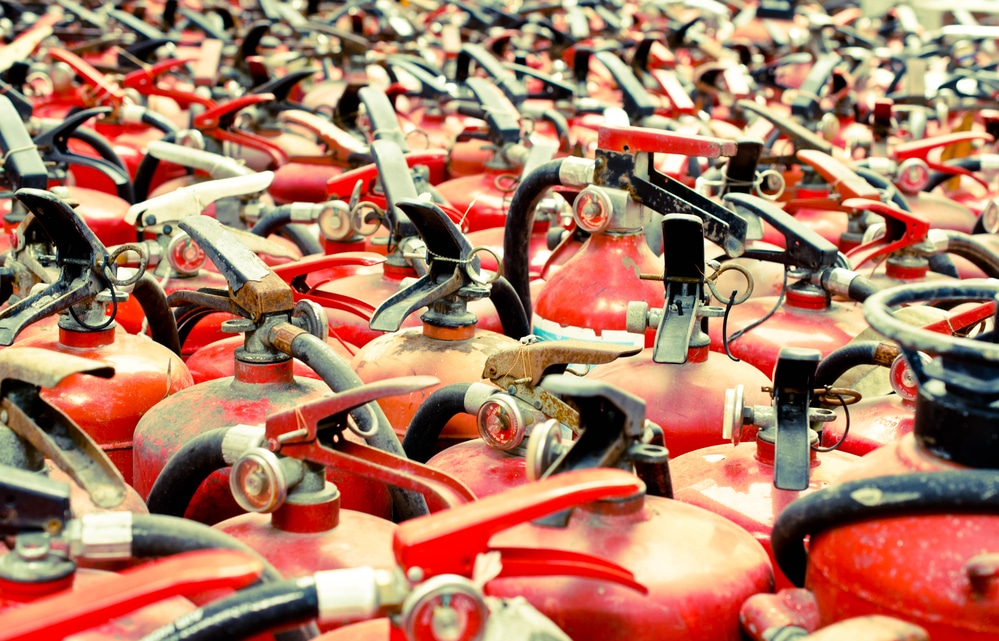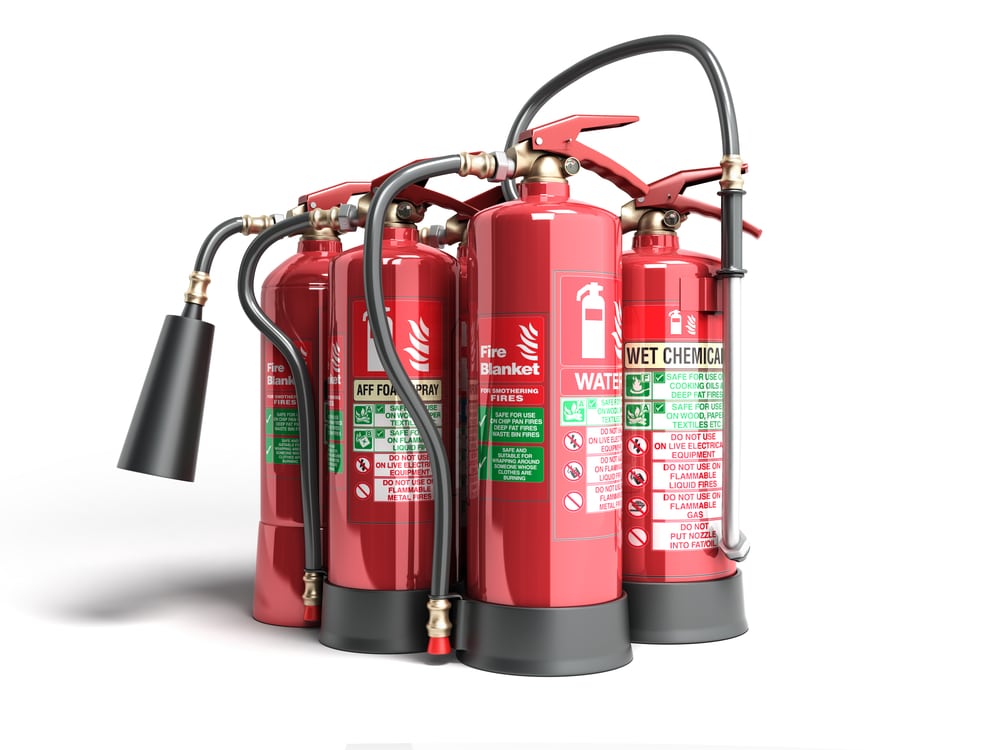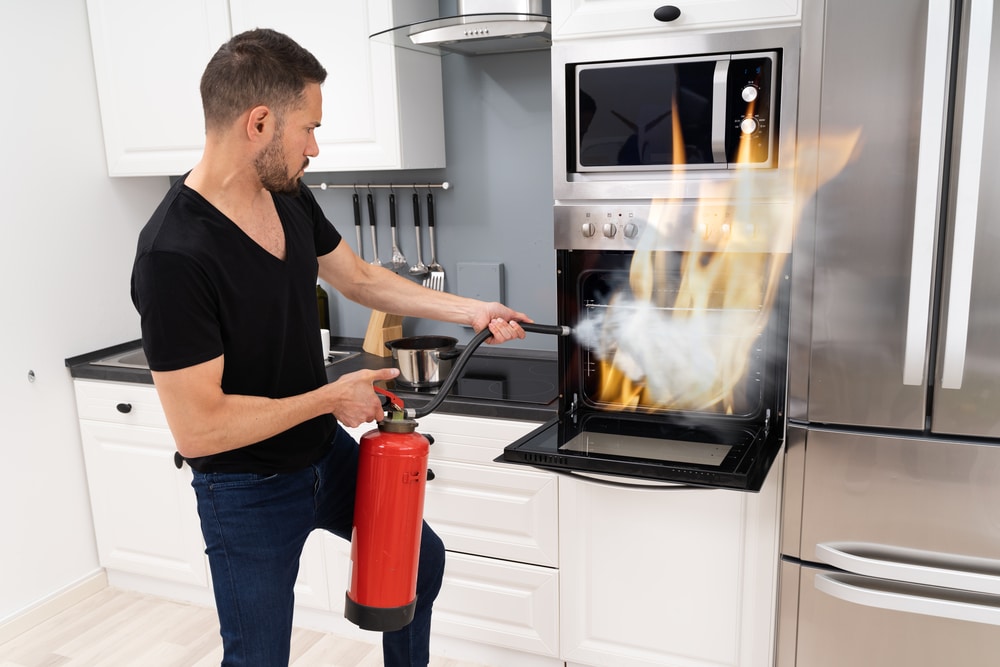Choosing the Right Fire Extinguisher for Your Home or Office

Per the National Fire Protection Association, there is a minimum set of safety standards home, and business owners should follow to mitigate the risks of uncontrolled fires in their houses or workplaces. These standards include owning and maintaining the appropriate number of fire extinguishers for the size of the space.
Fire extinguishers are among the most important tool for fire safety. They enable home and business owners to extinguish fires on their properties before they grow out of control, potentially saving lives and avoiding catastrophic damage.
There are many extinguishers, so choosing the best one to suit your needs is crucial.
Keep reading for expert tips on choosing the right extinguisher for your home or office. Then, if you want to train your staff on using a fire extinguisher, we also have a Fire Extinguisher Training Course.
Understanding Fire Extinguisher Classification
Fire extinguishers are categorized in four main ways: by weight, by classification rating, by content type, and by UL rating.
Since extinguishers disrupt the chemical reaction involved in the fire’s combustion process, choosing the correct extinguisher for the type of blaze you’re dealing with is vital. The wrong extinguisher won’t effectively fight the flames; in some cases, it could even worsen the situation.
Let’s run through the four main categories fire extinguishers come in. Also, suppose you want to share fire extinguisher information with your employees. In that case, we also have a Fire Extinguisher Toolbox Talk that will give you some material to hold a short safety meeting with.

What Does a Fire Extinguisher’s Weight Mean?
Size is one of the most important considerations when choosing between home fire extinguishers. Most of the time, bigger fire extinguishers are better since they can put out larger fires.
A smaller, portable extinguisher might be the best option for small fires. If a small blaze catches in your office wastebasket, you might lose valuable time struggling to operate a heavy extinguisher when a five- or even two-pound canister would have done the job.
What Does a Fire Extinguisher’s Classification Rating Mean?
The classification rating determines the extinguisher’s effectiveness against certain types of fires. Different classes are designed to handle fires burning on different varieties of materials, such as ordinary combustibles, flammable liquids, and animal oils.
- A: These extinguishers can handle Class A fires. They can be dry chemicals or wet chemical extinguishers. Class A fires are blazes occurring in ordinary combustible materials like cloth, wood, paper, and plastics.
- B: Class B fires occur in flammable liquids, oil-based paints, grease, gasoline, alcohol, lacquers, and flammable gases. Class B are typically dry chemical extinguishers and typically contain sodium bicarbonate, also known as baking soda.
- C: Class C fires involve energized electrical equipment. All electrical fires are considered class C fires. An extinguisher with a “C” rating uses an extinguishing agent that doesn’t conduct electricity, usually a dry chemical.
- D: Class D fires involve burning metals. Examples of combustible metals include lithium, sodium, potassium, and titanium. These are the primary fire extinguishers used in laboratories that conduct combustible metals research.
- K: Class K fires involve cooking oil, such as animal fats and vegetable oil. Class K extinguishers are generally wet chemical extinguishers.
Many extinguishers in the home and office are ABC extinguishers, effective on A, B, and C fires.
What’s Inside My Fire Extinguisher?
Fire extinguishers contain different extinguishing agents depending on their classification and the types of fires they are meant to control.
Class A extinguishers usually contain mono ammonium phosphate, effectively disrupting the chemical reaction within ordinary combustibles.
Class B and C extinguishers contain dry chemicals like powder and carbon dioxide.
Some extinguishers contain water as their primary extinguishing agent. These are best suited for use on fires involving oxidizing chemicals, which react poorly to wet and dry chemicals.
What Does the UL Rating Mean?
Designated by the Underwriters Laboratories, the numerical ratings on a fire extinguisher explain its effectiveness compared to other extinguishers.
The water equivalency portion of the UL rating tells you how much of a blaze you can expect your Class A extinguisher to be able to quench. Each point of the rating is equivalent to 1.25 gallons of water.
For example, a 2A extinguisher is approximately as effective as 2.5 gallons of water.
The number before the letter indicates how large a conflagration the extinguisher can put out measured in square feet on B and C fire extinguishers.
Putting It All Together
You have an ABC extinguisher with the following UL rating: 4A 30B:C. Your extinguisher has a water equivalency of 5 gallons of water and can cover up to 30 square feet.
Thanks to the letter rating, you can also determine that your extinguisher can put out the following types of fires:
- Class A fires (ordinary combustibles like wood and paper)
- Class B fires (flammable liquids and gases)
- Class C fires (those sparked by electrical equipment)
A ten-pound extinguisher of this type would be suitable for putting out most home fires.

Choosing the Right Fire Extinguisher for Home or Office Use
The National Fire Protection Association (NFPA) recommends keeping at least one extinguisher on each floor of your home. They should be spaced no more than 40 feet apart.
You may require additional extinguishers depending on how large your house is. Different extinguisher types and sizes are suitable for different areas of your home.
Since offices often have larger square footage than most homes, they typically require multiple extinguishers on each floor.
Here are a few suggestions covering the best fire extinguishers for different parts of the home and office.
Laundry Room
Dryer lint is a major fire hazard, particularly when it’s allowed to build up over time. Dryer fires can spark quickly and spread rapidly, so a fast response time is crucial.
Select a lighter, more maneuverable extinguisher for your laundry room. A five-pound canister with a hose should serve you well.
Home Workshop or Garage
Home workshops and garages typically contain abundant combustible materials and potential fire hazards, including wood shavings, paper scraps, electrical equipment, and more. Fires that begin in these conditions might start out small enough to escape notice, then grow into a bigger threat over time.
It’s best to choose a heavier extinguisher for your workshop or garage. A ten-pound rechargeable ABC extinguisher is a good option. Choose one that can extinguish a fire from 20 to 40 square feet, depending on the size of your workshop.
Pool House
Water extinguishers are the only type that should be used to snuff out oxidizers like pool chemicals. Never use an ABC extinguisher for this type of fire.
Offices
Most workplaces have a fire safety plan that includes provisions describing how many extinguishers each floor of the office should have.
A class C or ABC extinguisher should be positioned near any electrical equipment in the workplace. Additional ABC extinguishers should be placed at easily visible points spaced no more than 40 feet apart around the office.
Office extinguishers shouldn’t be too unwieldy; everyone in the workplace needs to be able to operate them. Ten-pound extinguishers with an extinguishing capability of 30 square feet are sufficient for use in most standard offices.
Remember to keep a fire extinguisher near each exit and in the office kitchen and break room. Ensure everyone in the office knows how to operate a fire extinguisher correctly.

Kitchens
Kitchen fires are usually class K, meaning they involve cooking oils. However, a kitchen fire could also be started by electrical shorts in cooking appliances, which are class C. A fire ignited by cooking gas would be considered class B.
Having at least two types of fire extinguishers in your home kitchen is recommended. Both ABC and class K fire extinguishers are necessary to ensure your cooking space has adequate fire protection.
Consider using mounting hardware to install a small ABC fire extinguisher over your stove top, and install a larger extinguisher with a Class K rating nearby.
A commercial kitchen fire has the potential to cause catastrophic damage. Commercial kitchens should have ABC and K extinguishers positioned by each stovetop or oven and near the exits.
Should I Get a Disposable or Rechargeable Extinguisher?
Disposable extinguishers are cheaper than rechargeable ones. They have plastic rather than metal valves, and they are single-use, meaning they need to be replaced after discharge.
Though more expensive, rechargeable extinguishers are more cost-effective in the long run because they can be refilled. The metal valve is sturdier and more reliable than the plastic valve on a disposable model.
Whichever type you choose, pick one from a major manufacturer with rigorous testing standards and no recent history of malfunctions or product recalls. Look for recommendations from the NFPA.
Notes on Fire Safety in the Home and Office
While keeping fire extinguishers in your home is a necessary facet of fire safety, just buying a fire extinguisher and storing it away isn’t enough. You need a comprehensive safety plan that tells everyone in the household or office what to do in the event of an emergency.
Here are a few tips to get you started.
1. Keep All Fire Extinguishers in an Easy-to-Grab Spot
A fire extinguisher is only effective if it’s in an easily accessible place. Keep yours in plain sight and within reach. Don’t store extinguishers in a closed cabinet.
Ensure everyone in the house or office knows the location of each fire extinguisher and how to operate it. Incorporate fire extinguisher training into your onboarding process.
2. Keep Up With Maintenance
Your home or office extinguishers should be inspected and serviced by a licensed and certified company at least once per year. After 12 years, your extinguisher should be pressure tested to ensure it’s still functional.
Each time they service your fire extinguisher, the company will make a note on the extinguisher’s tag with the date of the inspection and the name of the person providing the service. Consult the tag often to ensure you’re staying on top of maintenance.
If your extinguisher’s pressure gauge has gone from green to red, it’s time to replace or refill it. You must also replace your disposable extinguisher or refill your rechargeable one after each use – even if the extinguisher isn’t empty.
3. Have a Detailed Fire Safety Plan
Everyone in your home or workplace should know what to do if there’s a fire. This safety plan should include the following:
- The location and operation of every extinguisher in the space
- Any known fire hazards
- How to exit the building
- Where to go after exiting
- Which emergency services personnel to call
Keep the phone numbers and contact information for local emergency services – including the fire department – in a central location.
For additional resources on creating a fire safety plan, consult the National Fire Protection Association’s website.
4. Ensure Proper Extinguisher Use
Having fire extinguishers won’t do you any good if you don’t know how to use them. The acronym “PASS” will help you remember the correct steps.
- P: Pull the pin. Keep the nozzle pointing away from you as you release the locking mechanism.
- A: Aim low. Point at the base or source of the blaze, not at the flames themselves.
- S: Squeeze the lever slowly. Use firm and even pressure.
- S: Sweep from side to side.
Train your employees and household members how to use each type of extinguisher in the space. Refer to your owner’s manual or check with your manufacturer if there’s anything you’re unsure about.
5. Contact the Fire Department
You need to call emergency services whenever a fire breaks out in your home or business. Even a small fire can have lingering embers that could reignite at any time.
If possible, evacuate your home or office building and wait outside at a safe distance until the firefighters arrive. Follow all directions issued by emergency personnel, and don’t return inside until you are cleared to do so.

Prioritize Fire Safety – Choose the Right Extinguisher For Your Home or Office
The more prepared you are, the better your chances of controlling and extinguishing fires in your home or office before they injure people or destroy your property. That means ensuring you have the correct extinguishers for each floor or room in your house.
Research your options carefully before purchasing an extinguisher, and look for recommendations by experts like the National Fire Protection Association to ensure you’re getting the right one for your needs.
Frequently Asked Questions
An ABC extinguisher is a good all-around choice for office use. Install at least one fire extinguisher on every floor. For large spaces, position an extinguisher every 40 feet and in separate areas like the kitchen and break room.
Class B dry chemical fire extinguishers are designed to work on fires started by flammable liquids and gases.
In a home office, your most likely fire starters are ordinary combustible materials such as paper. A small ABC extinguisher mounted near your desk, door, or wastebasket should suit your needs.
Consider the following factors before choosing your fire extinguisher(s):
– The types of fire hazards present in your home or office
– The extinguisher’s effectiveness and how large a fire you might need to put out
– How heavy a canister you can move and manipulate easily
– Whether you want a rechargeable or a disposable canister
Commercial fire extinguishers tend to be much larger than those found in the home, often needing to be transported on wheels. You also aren’t likely to see a Class D extinguisher in the average home since they’re primarily for extinguishing flames caused by burning metal.